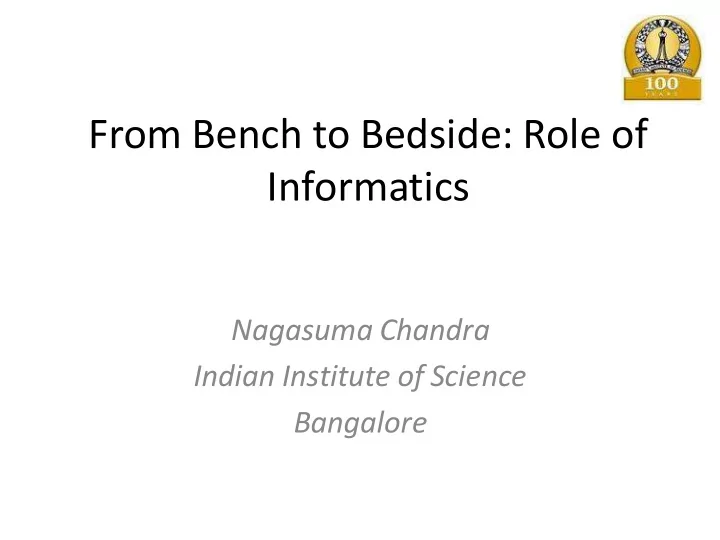

From Bench to Bedside: Role of Informatics Nagasuma Chandra Indian Institute of Science Bangalore
Apparent ‘disconnect’ among DATA pieces STUDYING THE SAME SYSTEM Echocardiogram Chest sounds Blood tests Conductance Stress Test Blood pressure Heart Electrocardiogram
Navigating across multi-scale multi- level biological systems 3
Structuring Complexity in Engineering Early models of engineered system behaviour are cognitive models of the system as described by experts Engineering has used- Tacit knowledge, Rules, Experience These help in defining physical behaviour to some extent- however knowledge in rules not sufficient Need physical laws to be obeyed and tested with experiments Therefore quantitative -- measurable mathematical models and simulations are needed at various fidelity levels Courtesy: Chandra S; National Aerospace Laboratories 4
Learning from Engineering Has a well-defined blue-print Provides clues to Structuring Complexity Need to obtain a blue-print for biological systems as well 28 particles Physics for 10,750 (a) Basic understanding of the Chemistry chemicals living systems & ~ 1 trillion trillion Biology (b) Application in Medicine & components Biotechnology BUT Problems associated are • Too many players • Highly complex interactions 5 Chandra N & Chandra S; Microsoft e-science workshop, October 2009
Challenges in studying biological systems Several challenges must be met however, in order to study biological systems. formulate biological questions as network amenable problems, reconstruct networks with appropriate resolution from available data. establish relationships within each layer of data but more importantly among different levels of data, to identify and understand the flow of information in terms of biochemical, biophysical structural and molecular signals within a cell, leading to various biological events . 6 Chandra N & Chandra S; Microsoft e-science workshop, October 2009
Hierarchical structures in living systems Cell Tissue Organ Organelle Macromolecule Supramolecular Organism assembly
Psychological Biochemical Spiritual Pharmacological MEDICINE Prevention Diagnosis Treatment Alternate Medicine Physiological Molecular Basis of Medicine
Integrated Systems Approach 9
Understanding a cell Proteins Metabolites Biochemical reactions Gene pool Phenotype MSFVVTIPEALAAVATDLAGIGSTIGTAN AAAVPTTTVLAAAADEVSAAMAALFSGHA QLAYQALSAQAALFHEQFVRALTAGAGSY Environment of phenotype Descriptions: Sequences (f n implicit) Structures Metabolites Biochemical Reactions (f n explicit) Regulation elements Network of proteins/metabolites/reactions
Genomics Proteomics Model Scale / Complexity Genome sequence Network Functional Annotation Stoichiometric Matrix Resolution of information Temporal Profiling Structure d X Differential Equation Binding Site Schrodinger Equation Applications
Taxonomy of Models Low granularity High granularity Qualitative Models Machine Learning Statistical Models Bayesian Networks Network Topological Analysis Boolean Modelling Stoichiometric Matrix Flux Balance Analysis d X Stochastic Modelling Differential Equations Molecular Recognition Models Atomistic Models
M.tuberculosis : A successful pathogen Tuberculosis has been present in humans since antiquity (Earliest evidence in prehistoric humans – 7000 to 18000 BC) 4000 proteins 1000+ biochemical reactions; 100s signalling / regulatory events High redundancy in the genome Robust system Contains several immune evasion mechanisms Dormant state that can reactivate after decades to cause active disease Many people infected but do not contract the disease A multi-level view necessary
COMMON DESIGN PRINCIPLES ACROSS DIVERSE EXPRESSIONS OF LIFE 1.5 to 1.8m • 100 trillion cells • Each cell • 3 billion base pairs • 4 million base pairs • 20000-25000 proteins • 4000 proteins • 210 distinct cell types • 2-4 μ in length • 1000 metabolites • 0.2-0.5 μ in width • 400 billion chemical • 4000 X 10000 atoms reactions every second 2-3 droplet nuclei Human Macrophage Three dimensional structure of one protein Phagocytosis of the bacteria Contains ~10,000 atoms By a human macrophage Protein-Protein interaction Pathway- ~ 15 proteins network
Biochemical networks
Cellular Networks Abstraction of the flow of information that leads to Drug Resistance in TB bacilli Raman and Chandra, 2008, BMC Microbiology 17
Structural Bioinformatics
Virtual screening in drug discovery/design Ligand size: ~ 10-50 atoms (flexible) Protein size: ~ 2000-5000 atoms (rigid) 1 docking run: ~ 10 6 energy evaluations on a high-end PC => CPU time ~ 30min . Modest Ligand database: ~ 10 6 compounds Protein molecules are NOT rigid & multiple conformations must be sampled A database search requires: ~30min * 10 (protein conformations) * 1 million (ligands in database) ~ 5*10 6 hrs. How about studying several proteins?
Host-Pathogen Interaction Modelling: Predicting disease outcome A Boolean model of HPIs developed, Simulations to capture a variety of scenarios 20 Raman, Bhat & Chandra, Mol. Biosyst, 2010
Biological Design- Outcome of a random ‘tinkering’ process (Evolution) Engineering – Built on purpose with a pre-designed blue-print 21 From - Chandra N & Chandra S; Microsoft e-science workshop, October 2009
Data Integration • Data Resources- Primary & Derived Databases » cross mapping- across databases • Data descriptions • Data representation-Data structures, Syntaxes • Data Integration • Data InterRelationships- Ontologies • Data flow pipeline – A biology workbench?? • Data Visualization • Simulation tools- Iterative with model development
Encoding Inter-relationships
Integrated modelling
Abstraction of the flow of information that leads to Drug Resistance in TB bacilli Math Description Problem Integrated models Math Description Applications Math Description Applications Applications Definition Genome Proteome Topology Geometry, Topology Geometry, Topology Geometry, Network reconstruction Initial Conditions, Initial Conditions, Initial Conditions, Source/ Sink identification Boundary Conditions, Boundary Conditions, Boundary Conditions, Diffusion Coefficients, Concept of emergence of Simulations Diffusion Coefficients, Diffusion Coefficients, Biological Insights Pseudo-steady, Simulations drug resistance Pseudo-steady, Pseudo-steady, Enable/Disable Reactions Simulations (2) (1) Enable/Disable Reactions Enable/Disable Reactions Ontologies Timestep, Timestep, Mesh Protocols Timestep, Mesh Size, Syntaxes Mesh Size, Parameter Images Size, Images Images Parameter Results New Clues for Searches, Data cross- Parameter Results Searches, Sensitivity Drug Discovery Results mapping Searches, Sensitivity Sensitivity
Potential of Translation Systems Biology • Patient GENOTYPE profile – molecular, Biochemical, life style, gene history • Informatics- Identify disease, disease type, patient type, predict risk of patient for a given disease • Understand molecular basis of disease, identify causative proteins, biochemical, signalling pathways • Identify optimal strategy for tackling disease • Choose best therapeutic intervention tool, drug, vaccine, other clinical tools • Predict outcome of therapy with the chosen agent- PHENOTYPE • Pharmacogenomcis, Personalized prescriptions • Monitor patient, populations, Learn…
Recommend
More recommend